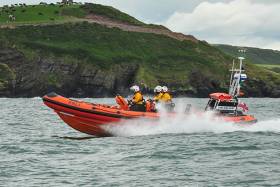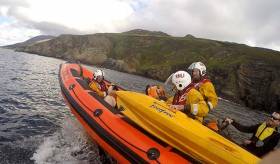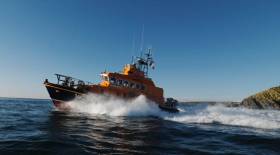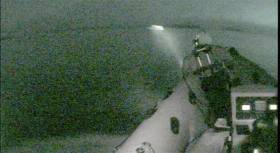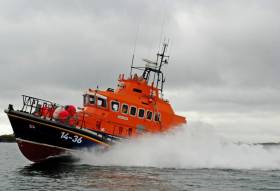Displaying items by tag: RNLI
Crosshaven RNLI Lifeboat Assist Anglers After Breakdown
Crosshaven RNLI Lifeboat in Cork Harbour was requested to launch yesterday evening at 9.45pm to reports of a speedboat broken down and adrift approximately one km south west of Trabolgan.
In calm conditions with a slight sea,the volunteer crew, under the command of Alan Venner with Ian Venner, Aoife Dinan and Vince Fleming on board headed to the area at best speed.
On arrival, the two anglers onboard the vessel had attempted remedial work with no results. The crew of the lifeboat then established a tow and landed the casualty at Crosshaven boatyard.
The lifeboat returned to station at 11.30pm and is currently being washed down and refuelled by the shore crew before being declared ready for service.
Three Callouts To Help Vessels In Difficulty For Donaghadee Lifeboat
#RNLI - Donaghadee RNLI was called upon three times in the last week to assist vessels which got into difficulties off the coast of North Down.
The first callout was on Thursday 25 August after a yacht with five people aboard struck rocks at the South Briggs buoy in the Copeland Sound.
At the scene, the crew of the all-weather lifeboat Saxon established that no one was injured and the yacht was still seaworthy.
The volunteers and the lifeboat escorted the vessel to a safe harbour for full inspection of the damage to the hull. Conditions were calm.
Saturday 27 August also saw a fine and calm summer’s evening when a RIB with five aboard set off from Scotland for Bangor, but encountered engine failure in the middle of the North Channel as night began to fall.
An emergency call was made to Belfast Coastguard and the lifeboat was requested to respond. The drifting RIB was quickly located eight miles from the Scottish coast. A tow-line was secured and the helpless boat and passengers were in Bangor before last light.
Saxon and crew were called out again on Bank Holiday Monday yesterday to come to the rescue of a small fishing boat with one person aboard.
The eight-metre vessel suffered engine failure and began dragging its anchor in choppy conditions near rocks at Burial Island off Ballyhalbert.
The boat was towed to Portavogie for repairs by another vessel and the lifeboat escorted the pair safely to harbour.
Six Rescued in Two Separate Call Outs for Clifden RNLI
Clifden RNLI rescued six people in two separate call outs off the Connemara coast last week.
On Friday afternoon, the volunteer lifeboat crew was requested to launch their all-weather and inshore Atlantic 85 class lifeboats following a report that two people were in the water after their 6ft boat had ran aground and hit rocks.
The lifeboat helmed by Joe Acton and with crew members Dermott Clancy, Alvin Bell and Kenneth Flaherty onboard, launched within minutes and made its way to the scene on the south east side of Davillaun.
With a report that two people had entered the water, the Irish Coast Guard’s helicopter Rescue 118 from Sligo was also tasked and a pan-pan was put out to all vessels in the area to assist in the operation.
Weather conditions at the time were described as dry but blowing a Force 5-6 gale with a choppy sea and a good ground swell.
Clifden’s inshore lifeboat was the first vessel to arrive on scene where the crew observed that the two men had managed to get themselves on the rocks. They were cold and wet and holding on to their boat to keep it afloat.
Lifeboat crew member Alvin Bell was put onto the rocks where he assessed the casualties and ensured they were ok. With no injuries sustained he then proceeded to help them on to the lifeboat where they were further assessed and made comfortable. A towline was then set up and the casualty vessel was pulled off the rocks and brought alongside the lifeboat to prevent further damage.
Following an hour long tow, the two men and their vessel were brought safely back into Derryinver Pier.
Earlier in the week, the lifeboat was called upon on to assist the crew of a 35ft trawler that had got into difficulty on Clifden Bay.
The Atlantic 85 inshore lifeboat was requested to launch at 11.30am on Tuesday (23 August) after gear got tangled in the prop of the trawler resulting in no steerage and no propulsion.
The lifeboat helmed by Joe Acton and with crew members Alvin Bell, Kenneth Flaherty and Eoin Hayes onboard, made its way to scene where they worked with the four crew onboard to set up a towline.
Weather conditions were good with a flat calm sea. However, with the boat running against the tide, helm Joe Acton called on the assistance of Clifden’s D class inshore lifeboat which on arrival helped with the safe manoeuvre of the trawler into the quay at Clifden.
Speaking following the two call outs, Clifden RNLI helm Joe Acton said: ‘We were happy to be of assistance on both occasions last week. Friday’s call out was a bit more challenging following the initial report that two people were in the water but thankfully they had managed to make it on to rocks where they were waiting safe and well if not cold and wet following their ordeal.
‘We would encourage anyone taking to the sea for work or pleasure, to enjoy it but to always respect the water. Always wear a lifejacket and carry a means of calling and signalling for help. Always check the weather forecast and tide times. Make sure someone ashore knows where you are going and who to call if you don’t return on time. Learn how to start, run and maintain your engine before taking to the water.’
Lough Swilly RNLI lifeboat rescued a sheep this afternoon after it fell approximately 200 feet from a cliff in County Donegal.
The alarm was raised at 4.30pm today when three local fishermen spotted the animal stranded on a ledge in a ravine at Leenan Head with no means of escape.
The fishermen contacted Malin Head Coast Guard and Lough Swilly’s inshore Atlantic 85 lifeboat was requested to launch.
Weather conditions at the time were described as good with a flat calm sea.
Once on scene, the volunteer lifeboat crew were met by the fishermen who pointed to where the distressed sheep was located. A kayaker who had also arrived on scene, first paddled in close to the cliff in an attempt to encourage the animal back up the hill.
With this failing to work, the lifeboat crew and the kayaker proceeded to enter the water and make their way towards the sheep where they safely caught her and gently placed her in the kayak before transferring her into the lifeboat.
Once onboard the lifeboat, the sheep was comforted by the crew and safely brought back to more familiar surroundings on shore.
Speaking following the call out, Joe Joyce, Lough Swilly RNLI Volunteer Lifeboat Press Officer said: ‘We think the young sheep had fallen about 200 feet and with nowhere to go she was shaking from her ordeal by the time we took her onboard the lifeboat. The RNLI is often called upon to rescue animals and we are always happy to assist not only to bring them to safety but also to ensure the safety of pet owners or farmers who may risk their own life in attempting to bring their animal safely back to shore.’
Injured Fisherman Rescued By Ballycotton Lifeboat
#RNLI - Ballycotton RNLI came to the rescue of an injured fisherman who got his hand cut when attempting to untangle a net this morning (Friday 26 August).
The volunteer crew launched their all-weather and inshore lifeboats at 8.30am after the man, who was fishing at Ardnahinch in East Cork, raised the alarm.
The fisherman had been attempting to untangle a net which had got caught in his boat’s propeller when he got into difficulty.
The all-weather lifeboat, under coxswain Eolan Walsh and with five crew members onboard, launched along with the station’s boarding boat with two crew members. Weather conditions at the time were described as good with moderate Force 3-4 south-westerly winds.
The lifeboats made their way to scene 1.5 nautical miles from Ballycotton, where the smaller boarding boat was able to gain good access to the casualty vessel.
A crew member went onboard the boat and assessed the fisherman before applying a bandage to his hand. The man was then transferred to the all-weather lifeboat and given further casualty care by crew member Claire McCarthy, who is also a nurse. The casualty was treated with no further medical assistance required.
As the all-weather lifeboat proceeded to bring the fisherman safely back to shore, the crew on the boarding boat worked to set up a towline before bringing the fisherman’s boat back to Ballycotton.
Speaking following the callout, Walsh said: "The fisherman did the right thing this morning and called for assistance when he found himself in difficulty and we would like to wish him a speedy recovery following his injury.
"We would encourage everyone whether they are using the sea for work or leisure to always respect the water. Always wear a lifejacket and carry a means of calling for helping and know how to use it should you get into trouble."
Ballyholme Beach Faller Thanks Bangor Lifeboat Crew For Her Rescue
#RNLI - Geraldine Donnelly paid a visit to Bangor RNLI earlier today (Thursday 25 August) just weeks after her rescue following a serious fall on Ballyholme beach.
On 7 June last, Donnelly fell more than two metres onto rocks and shingle from Ballyholme Esplanade after one of her two dogs pulled its leash and over-balanced her, as previously reported on Afloat.ie.
After five weeks in the Ulster Hospital and another four receiving physiotherapy, Donnelly is now back on her feet, although full recovery could be a year away.
Today she met three of the lifeboat crew involved in her rescue – helm Mickey McKenna, John Bell and Richard McClinton. A fourth crew member, Ian Browne, sent his regards as he is currently working overseas.
"As soon as I fell, I knew it was serious, and if it wasn’t for the RNLI, I really don’t think I’d be alive today," she said today as she praised the Bangor RNLI crew for their actions, in particular "her angel" John Bell, who held her hand throughout her ordeal.
"Every day since the accident, I’ve wanted to thank you for your kind words and for holding my hand," she said. "It made such a difference, and kept me calm; something the doctors say prevented the injury being even worse."
Early Morning Calls Lead To Lifeboat Launch on Lough Derg
Lough Derg RNLI Lifeboat launched at 5.20am, following reports to Gardaí of calls for help coming in off the lake.
At 05.06am this morning, Lough Derg RNLI Lifeboat was requested to launch by Valentia Coast Guard, following a report to Nenagh Gardaí of calls for help heard coming in off the lake, that woke sailors camping at Lough Derg Yacht Club.
As volunteer crew assembled, they were informed by Gardaí, who were at the Lifeboat Station, that a cruiser was seen to leave the public harbour close to the time the calls for help were heard.
The lifeboat launched at 05.18am with helm Eleanor Hooker, Ger Egan and Owen Cavanagh on board. Winds were light, southeasterly. Visibility was poor with fog and just before dawn.
The Irish Coast Guard Search and Rescue Helicopter team based at Shannon, were on standby should they be required.
The lifeboat set a route south, in the direction from which the calls were heard, and using a search light quickly located a cruiser at anchor close to the navigation channel, south of the Corrakeen Islands, outside Dromineer Bay.
The lifeboat crew roused the passengers on board and made them check that everyone was accounted for on board. The passengers said they may have been making some noise as they left the harbour earlier, and would be continuing their passage south at daybreak.
The lifeboat reported their findings to Valentia Coast Guard and, advised that the cruiser’s companion boat was moored in Dromineer Harbour, would check that they had no difficulties.
Once it was established neither vessel was missing a passenger, the lifeboat returned to station.
Brian Hanley, Deputy Launching Authority at Lough Derg RNLI Lifeboat, advises boat users to ‘respect the water, enjoy the lake, but ensure one person remains fully in command of your boat at all times’.
The lifeboat returned to Station and was ready for service again at 06.10am
#RNLI - Fethard RNLI assisted a man who got into difficulty off the Wexford coast yesterday evening (Tuesday 23 August) as he attempted to move between two boats.
The volunteer lifeboat crew launched their inshore lifeboat at 9.35pm following a request by the Irish Coast Guard that a man had entered the water at the Coal Yard in Cullenstown.
The lifeboat, helmed by John Colfer and with crew members Thomas Stafford, Finola Foley and Cathal O'Connell onboard, launched immediately from Fethard and proceeded five nautical miles to the scene.
Weather conditions at the time were described as calm with a Force 3 west to north-westerly wind.
The casualty, who was wearing a lifejacket at the time, had been manoeuvring from one vessel to another when he entered the water and got into difficulty. A member of his party who had already come ashore raised the alarm.
Shortly before arriving on scene, the crew received communication from the coastguard that the casualty had managed to swim ashore. On arrival, the lifeboat crew safely transferred the man into the D class inshore lifeboat Trade Winds and administered first aid.
The crew brought the casualty straight ashore at the Coal Yard, where members of the local coastguard unit were also on site. The volunteer crew continued first aid until the arrival of an ambulance that transferred the casualty to hospital as a precautionary measure.
Speaking following the callout, Fethard RNLI deputy launching authority Tony Molloy said: "Every minute counted this evening due to the period the casualty had spent in the water and the external temperature.
"The bar of the lough at Cullenstown can be quite a treacherous to manoeuvre in darkness, so the knowledge and skill set of the crew who know the area and the manoeuvrability of the D class inshore lifeboat was essential in getting to the scene where the crew was able to respond rapidly.
"We would like to commend the casualty for wearing his lifejacket and the member of his party who raised the alarm when they started to experience problems. We wish them both well following their ordeal."
Molloy added: "Tonight’s callout was a fine example of good team work with our crew putting their training and skills into practice working alongside our colleagues in the local Irish Coast Guard unit."
This weekend sees the inaugural Waves Music Festival to raise funds for Fethard RNLI to secure a new inshore lifeboat, a major boost for which they received recently from host venue Loftus Hall.
Three Calls In 24 Hours For Donaghadee Lifeboat Volunteers
#RNLI - Donaghadee’s RNLI lifeboat Saxon put to sea three times in 24 hours during a busy weekend keeping aircraft passengers and pleasure sailors safe around the North Down coast.
The first call came at 5.30pm on Friday (19 August) when an inbound aircraft heading for George Best Airport reported technical problems and HM Coastguard requested a launch in keeping with established air emergency procedures. These ensure a swift response from lifeboats should an aircraft be forced to ditch at sea.
The Donaghadee lifeboat made its way at top speed of 25 knots to a designated location along the flight path. However, the aircraft was able to land without incident and the lifeboat returned to station. The operation also involved Bangor and Larne RNLI crews.
On Saturday morning (20 August), the Donaghadee crew launched around 11am after a report that a 20ft yacht had run aground on rocks at Craigbrain, near Ballyferris caravan park.
At the scene, the crew launched the smaller inflatable lifeboat in difficult conditions with a 1.5m swell, but established that no one was aboard the grounded catamaran.
Safety advice was given from coastguard officers on the shore and it was decided to let the incoming tide lift the yacht off the rocks to allow for a safer retrieval by the owner.
The crew had just returned to the boathouse at 12.30pm when the coastguard requested another launch. This time a 31ft yacht, with three people aboard, had reported an engine fire east off Burr Point near Ballyhalbert.
On the way, the lifeboat crew encountered treacherous seas with 5m waves, making for an uncomfortable passage.
Once on scene, the crew of the yacht confirmed they heard automatic fire extinguishers firing in the engine room. The lifeboat approached, secured a towline and set course for the difficult passage back to Donaghadee.
The stricken yacht was brought alongside and berthed in the harbour, where two appliances from the Northern Ireland Fire and Rescue Services attended as a precaution.
The lifeboat and her crew were back at sea on Sunday morning to conduct a regular training exercise.
Donaghadee RNLI deputy coxswain John Ashwood said: ”It has been a quiet summer for the crew so far but this weekend was one of the busiest 24-hour periods we have experienced in quite some time. We are always ready to respond if lives are in danger at sea.”
Seven Callouts In Five Days For Lough Ree Lifeboat
#RNLI - Lough Ree RNLI's volunteer lifeboat crew had one of their busiest periods ever in the last week, receiving a total of seven callouts over five days to assist people on and around Lough Ree.
The first callout came from the Irish Coast Guard shortly 2pm on Tuesday afternoon (16 August) to reports of a 35ft steel cruiser, with six onboard, aground between Athlone Lock and Clonmacnoise.
Later that afternoon, the crew was again called to assist a man aboard a 25ft sailing yacht aground near Barley Harbour on Lough Ree.
In both cases, the recovery was straightforward and no injury to crew or damage to vessels was incurred.
On Saturday (20 August), the lifeboat crew received three calls to assist vessels in difficulty amid very wet conditions with strong winds.
The first call came shortly before noon to assist three people on board a 33ft motor cruiser that had run aground at Bantry Bay on Lough Ree.
Shortly after 3pm, the lifeboat was again called to assist two people who had rowed a lake boat from Gailey Bay campsite to Quaker Island, but were then unable to row off the island due to the strong onshore breeze.
This was a particularly difficult recovery for the lifeboat crew. After trying several methods to tow the lake boat from the shore, a crew member was put ashore in the difficult conditions to push the lake boat off the shore while the lifeboat at anchor, pulled the tow line.
Eventually, the lake boat and its crew were recovered and the two casualties were brought on board the lifeboat, where they were given life jackets and wrapped in a blanket for warmth.
The lifeboat departed the scene with the lake boat on tow shortly after 5pm and proceeded towards Portrunny, the nearest harbour, where the boat and its rowers were delivered safely ashore.
Also on Saturday afternoon, the coastguard received a call for assistance from a motor cruiser with gear box failure south of Athlone Lock.
As the lifeboat was underway to Quaker Island at the time, Athlone Sub-Aqua Club in Athlone town were requested to assist the motor cruiser south of the lock.
On Sunday evening (21 August), the lifeboat was again requested by the coastguard, this time to assist a boat aground on Lough Ree.
The weather was significantly calmer than on Saturday and the recovery went smoothly, with no damage to the grounded vessel and no injury to its crew.
Commenting on Sunday evening, Lough Ree RNLI lifeboat operations manager Damien Delaney said,
"Our volunteer lifeboat crew have had a very busy few days," said Lough Ree RNLI lifeboat operations manager Damien Delaney after the Sunday evening callout. "We would urge everyone using Lough Ree to ensure they are familiar with the area and to take heed of any weather warnings issued by Met Éireann.
"Grounded vessels are not unusual but with any callout there are a number of factors that should be considered such as the wind direction, the weather conditions and the ability of crew and vessel to navigate these.
"It’s always a good idea for visitors to seek local advice before embarking on a journey on the lake, and to notify someone ashore of the intended departure time, destination and expected return time.
"Make sure you have a suitable means of calling for help and that you have the proper clothing and a lifejacket. You never know when you will need to call for help."



























